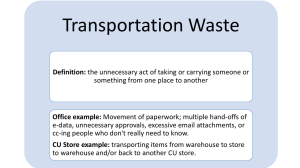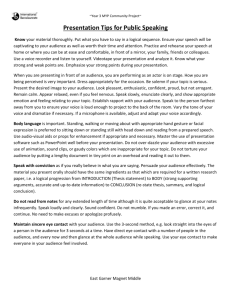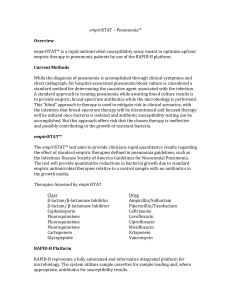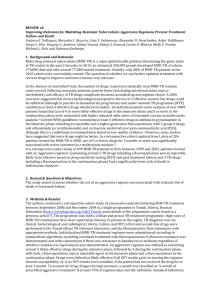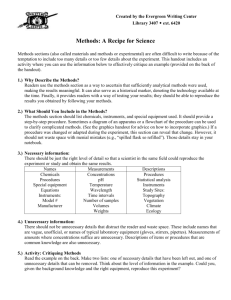Results - BioMed Central
advertisement
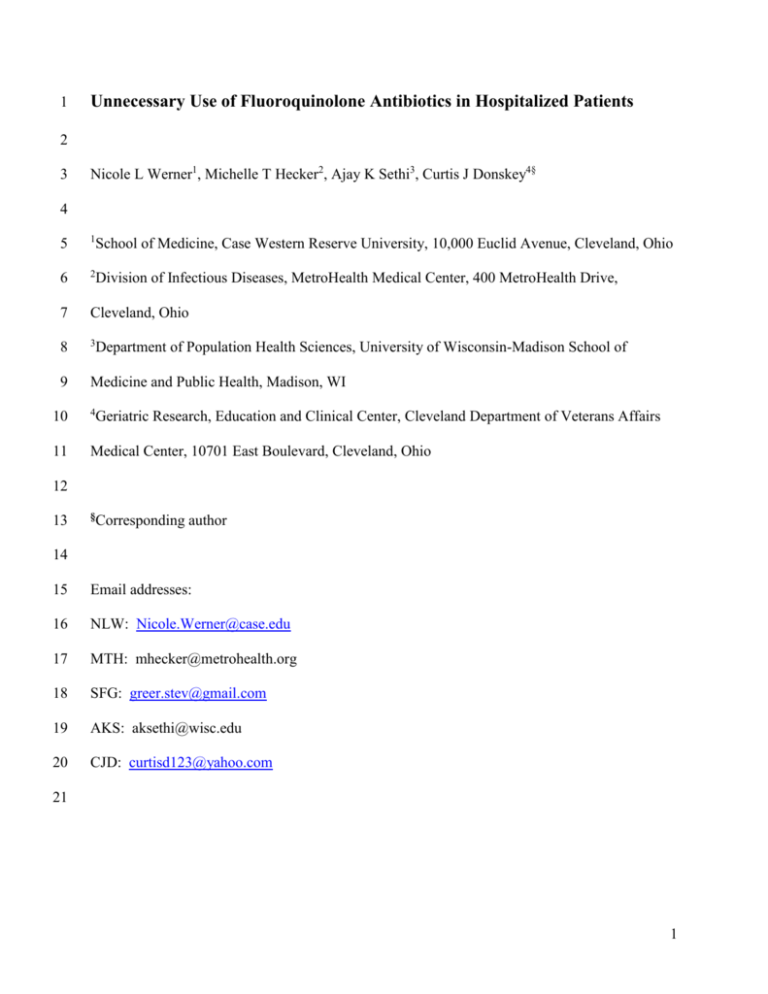
1 Unnecessary Use of Fluoroquinolone Antibiotics in Hospitalized Patients 2 3 Nicole L Werner1, Michelle T Hecker2, Ajay K Sethi3, Curtis J Donskey4§ 4 5 1 School of Medicine, Case Western Reserve University, 10,000 Euclid Avenue, Cleveland, Ohio 6 2 Division of Infectious Diseases, MetroHealth Medical Center, 400 MetroHealth Drive, 7 Cleveland, Ohio 8 3 9 Medicine and Public Health, Madison, WI Department of Population Health Sciences, University of Wisconsin-Madison School of 10 4 11 Medical Center, 10701 East Boulevard, Cleveland, Ohio Geriatric Research, Education and Clinical Center, Cleveland Department of Veterans Affairs 12 13 §Corresponding author 14 15 Email addresses: 16 NLW: Nicole.Werner@case.edu 17 MTH: mhecker@metrohealth.org 18 SFG: greer.stev@gmail.com 19 AKS: aksethi@wisc.edu 20 CJD: curtisd123@yahoo.com 21 1 22 Abstract 23 Background: Fluoroquinolones are among the most commonly prescribed antimicrobials and 24 are an important risk factor for colonization and infection with fluoroquinolone-resistant gram- 25 negative bacilli and for Clostridium difficile infection (CDI). 26 Methods: We conducted a 6-week prospective, observational study to determine the frequency 27 of, reasons for, and adverse effects associated with unnecessary fluoroquinolone use in a tertiary- 28 care academic medical center. For randomly-selected adult inpatients receiving 29 fluoroquinolones, therapy was determined to be necessary or unnecessary based on published 30 guidelines or standard principles of infectious diseases. Adverse effects were determined based 31 on chart review 6 weeks after completion of therapy. 32 Results: Of 1,773 days of fluoroquinolone therapy, 690 (39%) were deemed unnecessary. The 33 most common reasons for unnecessary therapy included administration of antimicrobials for 34 non-infectious or non-bacterial syndromes (292 days-of-therapy) and administration of 35 antimicrobials for longer than necessary durations (234 days-of-therapy). The most common 36 syndrome associated with unnecessary therapy was urinary tract infection or asymptomatic 37 bacteriuria (30% of all unnecessary days-of-therapy). Twenty-seven percent (60/227) of 38 regimens were associated with adverse effects possibly attributable to therapy, including 39 gastrointestinal adverse effects (14% of regimens), colonization by resistant pathogens (8% of 40 regimens), and CDI (4% of regimens). 41 Conclusions: In our institution, 39% of all days of fluoroquinolone therapy were unnecessary. 42 Interventions that focus on improving adherence with current guidelines for duration of 43 antimicrobial therapy and for management of urinary syndromes could significantly reduce 44 overuse of fluoroquinolones. 45 2 46 Background 47 Fluoroquinolones are among the most commonly prescribed antibiotics in outpatient and 48 inpatient settings in the United States [1]. Increases in the use of fluoroquinolones in recent 49 years have coincided with steady increases in the incidence of fluoroquinolone-resistance among 50 gram-negative bacilli in intensive care units [2]. In addition, fluoroquinolone exposure has been 51 associated with colonization and infection with other healthcare-associated pathogens, including 52 methicillin-resistant Staphylococcus aureus (MRSA), vancomycin-resistant enterococci (VRE), 53 and Clostridium difficile [3-5]. Reducing the use of fluoroquinolones may be an effective 54 strategy to limit the dissemination of these pathogens [6-7]. For example, a restriction program 55 that resulted in a 66% reduction in use of fluoroquinolones was associated with control of an 56 outbreak of C. difficile infection (CDI) associated with fluoroquinolone-resistant North 57 American pulsed-field gel electrophoresis type 1 (NAP1) strains [7]. 58 Several studies have demonstrated that fluoroquinolones are often used inappropriately 59 [8-12]. Lautenbach et al. [8] found that 81% of fluoroquinolone prescriptions in two academic 60 emergency departments were inappropriate based on institutional guidelines. In a French 61 teaching hospital, Mean et al. [9] found that 51% of fluoroquinolone regimens were 62 innappropriate based on local prescription guidelines. In a tertiary care hospital in Cleveland, we 63 found that 30% of all days of antimicrobial therapy were unnecessary, with ciprofloxacin being 64 the agent most often prescribed unnecessarily [11]. Other small studies have reported frequent 65 misuse of ciprofloxacin and levofloxacin in U.S. hospitals [11-12]. In order to develop effective 66 stewardship interventions, there is a need for additional data on current patterns of inappropriate 67 fluoroquinolone prescribing among hospitalized patients. Therefore, we performed a prospective 68 study to determine the frequency of, reasons for, and adverse effects of unnecessary 3 69 fluoroquinolone use in a tertiary care medical center. We hypothesized that longer than 70 necessary treatment durations would account for a significant proportion of unnecessary 71 fluoroquinolone use. 72 73 Methods 74 Setting 75 MetroHealth Medical Center is a 650-bed tertiary care hospital in Cleveland, Ohio. The hospital 76 has training programs for residents in internal medicine, family practice, obstetrics and 77 gynecology, and several surgical subspecialties. The fluoroquinolones on formulary are 78 ciprofloxacin and moxifloxacin. Fluoroquinolones are routinely prescribed for prophylaxis prior 79 to invasive urologic procedures, but not for prophylaxis of other procedures or conditions. The 80 hospital does not have a formal antimicrobial stewardship program and there are no restrictions 81 or specific guidelines on fluoroquinolone use. However, pharmacists are assigned to some 82 hospital wards to make antimicrobial recommendations regarding appropriate dosing, potential 83 medication interactions, and potential allergic reactions. Pharmaceutical company representative 84 are allowed to sponsor educational programs for trainees in the hospital and provide promotional 85 materials, but are not allowed to give presentations related to their products. During the year of 86 the study, the percent susceptibilities of Escherichia coli, Pseudomonas aeruginosa, and 87 Klebsiella pneumoniae to ciprofloxacin were 84%, 75%, and 95%, respectively. The percent 88 susceptibility of E. coli to trimethoprim-sulfamethoxazole was 81%. 89 Study Design 90 We prospectively examined the necessity of oral and parenteral fluoroquinolones administered to 91 adult inpatients during a 6-week period in May and June 2009. The study design was based on a 4 92 previous study of unnecessary use of antimicrobials in our facility [11]. Patients receiving new 93 prescriptions for fluoroquinolones were identified through daily review of pharmacy records. If 94 10 or less patients received new prescriptions for fluoroquinolones on a given day, all patients 95 were enrolled. If more than 10 patients received new prescriptions, 10 patients were randomly 96 selected to be included in the study using a random number generator. Patients were allowed to 97 be enrolled more than once if they received a second fluoroquinolone regimen at least 4 weeks 98 after completion of the initial regimen. The study wards included 6 medical wards, 3 surgical 99 wards, 3 intensive care units, 1 rehabilitation ward, 1 subacute skilled nursing ward, 1 psychiatric 100 ward, 1 obstetric/gynecologic ward, and the emergency department. Information regarding 101 demographics, admitting service and ward, indication for antimicrobial therapy (prophylaxis 102 versus treatment), concurrent antimicrobials, clinical syndrome being treated, laboratory data, 103 vital signs, radiological tests, and complications of therapy was obtained through medical record 104 review and recorded on a standardized data collection form. Patients were followed through 105 their entire hospital course, including transfers between hospital units. 106 Patients’ medical records were reviewed at least once during the course of antimicrobial 107 therapy and again six weeks after completion of therapy to assess whether possible 108 complications or adverse effects of unnecessary therapy occurred. The frequency of adverse 109 effects was calculated for all unnecessary fluoroquinolone regimens and for those unnecessary 110 regimens in which fluoroquinolones were administered as monotherapy. Colonization or 111 infection with a resistant pathogen (i.e., fluoroquinolone-resistant gram-negative bacillus, 112 vancomycin-resistant enterococci [VRE], or methicillin-resistant Staphylococcus aureus 113 [MRSA]) was considered a possible complication of therapy only if the patient did not have a 5 114 history of colonization or infection with these organisms prior to the start of fluoroquinolone 115 therapy; no routine surveillance for VRE or MRSA was conducted during the study period. 116 Infectious diseases specialists (M.T.H. and C.J.D.) determined whether the 117 fluoroquinolone regimens were necessary or unnecessary. A fluoroquinolone regimen was 118 defined as unnecessary if no antimicrobial therapy was indicated for the condition being treated 119 or if the fluoroquinolone component of a regimen was not indicated. If the fluoroquinolone was 120 determined to be necessary, additional assessments were made regarding whether part of the 121 fluoroquinolone regimen was unnecessary. Part of the fluoroquinolone regimen was considered 122 unnecessary if the duration of therapy was longer than recommended, the fluoroquinolone 123 provided redundant antimicrobial coverage in the absence of an indication for combination 124 therapy, the fluoroquinolone provided inadequate coverage of expected or documented 125 pathogens, and if the fluoroquinolone was continued despite negative evaluation for infectious 126 syndromes and/or a noninfectious condition was demonstrated to be responsible for the clinical 127 syndrome. 128 The determination of the necessity of the prescribed fluoroquinolones was based on 129 standard practice guidelines for management of infectious diseases developed and/or endorsed 130 by the Infectious Diseases Society of America [13]. For example, current guidelines for 131 asymptomatic bacteriuria recommend treatment only for pregnant women or individuals 132 undergoing invasive urologic procedures [14]; to diagnose asymptomatic bacteriuria we required 133 documentation that urinary symptoms were not present. If standard practice guidelines were not 134 available, diagnostic and treatment recommendations from a current textbook of infectious 135 diseases were used [14]. Hospital-acquired infections were defined by Centers for Disease 136 Control and Prevention criteria [15]. If fluoroquinolones were considered necessary, we 6 137 determined if there was an equally effective alternative agent that could have been prescribed. 138 The rationale was to provide an estimate of how much fluoroquinolone use could be safely 139 reduced if a hospital chose to implement a program of complete restriction of fluoroquinolones 140 in an effort to control C. difficile or resistant gram-negative bacilli. 141 To determine the contribution of fluoroquinolones to total antibiotic use in the hospital, 142 we examined pharmacy records for all antibiotics prescribed during the study period. The 143 proportion of total antibiotic use (days of therapy) that was made up of fluoroquinolone use was 144 calculated. In addition, for the year of the study, we estimated the costs of all fluoroquinolone 145 therapy and of the unnecessary fluoroquinolone therapy based on average wholesale prices and 146 on acquisition costs for the hospital. 147 Statistical analysis 148 Data were analyzed with the use of SPSS statistical software version 10.0 (SPSS Inc., Chicago, 149 IL) and STATA 9.1 (StataCorp, College Station, TX). Bivariate analyses were performed to 150 compare necessary and unnecessary treatment regimens. Continuous data were analyzed using 151 student’s unpaired t-tests. Categorical data were assessed using Pearson Chi-square test or 152 Fisher’s exact test. The hospital’s institutional review board approved the study protocol and 153 waived the requirement for informed consent due to the observational nature of the study. 154 Results 155 Two hundred twenty-six study subjects received 227 fluoroquinolone regimens during the study 156 period (1 patient was prescribed 2 fluoroquinolone regimens). The Figure summarizes the 157 findings regarding the necessity of fluoroquinolone regimens. Of the 227 fluoroquinolone 158 regimens, 70 (31%) were deemed unnecessary. These unnecessary regimens resulted in 391 159 days of fluoroquinolone therapy, which accounted for 22% of the total days of fluoroquinolone 7 160 therapy. Analysis of the 157 necessary fluoroquinolone regimens revealed that an additional 299 161 days of therapy were unnecessary. Overall, 690 of the 1773 (39%) days of fluoroquinolone 162 therapy were deemed unnecessary and 120 of the 226 (53%) study patients received at least one 163 day of unnecessary fluoroquinolone therapy. 164 Table 1 provides a comparison of the characteristics of patients receiving necessary 165 versus unnecessary fluoroquinolone regimens. Patients receiving unnecessary fluoroquinolone 166 regimens had an older median age than patients receiving necessary regimens (P=0.002); 167 however, there were no significant differences in regards to sex, previous hospitalizations, 168 previous antibiotics, long-term care residence, or comorbidities. A majority of the 169 fluoroquinolone regimens were prescribed on the medical wards or in the emergency department. 170 Only the family practice and rehabilitation medicine wards prescribed significantly more 171 unnecessary than necessary regimens (P<0.028). 172 Table 2 summarizes the reasons for the unnecessary days of fluoroquinolone therapy. 173 The most common reason for entirely unnecessary fluoroquinolone regimens was treatment of 174 non-infectious or non-bacterial syndromes or of colonization or contamination (292 days of 175 therapy), with asymptomatic bacteriuria accounting for 158 of the unnecessary days. For the 176 necessary regimens, the most common reason for unnecessary days of therapy was longer than 177 necessary treatment (234 days of therapy); longer than necessary therapy was attributable to 178 treatment for longer than recommended durations (121 days of therapy) or failure to discontinue 179 treatment when there was no evidence of infection (113 days of therapy). 180 Urinary syndromes, including asymptomatic bacteriuria, urinary tract infection, and 181 pyelonephritis, accounted for 51% of the unnecessary fluoroquinolone regimens. In addition, 182 urinary syndromes accounted for 36 of the 299 (12%) days of unnecessary therapy that were 8 183 prescribed as part of necessary regimens. In total, urinary syndromes accounted for 210 of the 184 690 (30%) unnecessary days of fluoroquinolone therapy. 185 For necessary fluoroquinolone regimens, we also assessed whether equally effective 186 alternative agents could have been used for therapy. Of 157 necessary regimens, 87 (55%) could 187 have been replaced with an alternative agent; these regimens accounted for 648 of 1773 (37%) 188 total days of fluoroquinolone therapy. The most common indications for which alternative 189 agents could have been used were gastrointestinal infections (22 regimens, 184 days of therapy), 190 pulmonary infections (21 regimens, 159 days of therapy), and urinary tract infections (21 191 regimens, 132 days of therapy). 192 Table 3 shows the adverse events associated with the 120 antibiotic regimens that include 193 unnecessary fluoroquinolone therapy (70 unnecessary regimens and 50 necessary regimens that 194 included unnecessary days of therapy). Gastrointestinal side effects were most frequent adverse 195 events, followed by colonization or infection with resistant organisms, Clostridium difficile 196 infection, and Candida infection. 197 During the study period, 11,304 total days of antibiotic therapy were administered to 198 inpatients. Fluoroquinolones accounted for 1,959 of the total days of antibiotic therapy (17%). 199 Ciprofloxacin was the most commonly used fluoroquinolone (1,627 days of therapy); 200 moxifloxacin accounted for the remaining 332 days of therapy. Assuming that fluoroquinolone 201 therapy during the study period was representative of usage patterns throughout the year, the 202 estimated total cost of all of fluoroquinolones administered in 2009 was $205,051 ($127,877 for 203 ciprofloxacin and $77,174 for moxifloxacin). Based on actual pharmacy acquisition charges, the 204 total costs of all fluoroquionolones administered in 2009 was $22,281 ($11,144 for ciprofloxacin 205 and $11,137 for moxifloxacin). If a stewardship program had been effective in eliminating the 9 206 31% of fluoroquinolone therapy that was considered unnecessary, the estimated cost savings for 207 the hospital based only on pharmacy expenditures during the year of the study would have been 208 ~$63,566 based on average wholesale prices or $6,907 in actual pharmacy acquisition costs. 209 210 Discussion 211 We found that 31% of fluoroquinolone regimens prescribed in our institution during the study 212 period were unnecessary. These unnecessary regimens accounted for 22% of all days of 213 fluoroquinolone therapy (391 of 1,773 total days of therapy). The most common reason for 214 unnecessary fluoroquinolone regimens was administration of antimicrobials for non-infectious or 215 non-bacterial syndromes. These findings are consistent with previous studies that evaluated 216 appropriateness of fluoroquinolone therapy regimens [8-11]. For example, Lautenbach et al. [8] 217 found that there was no evidence of infection in 33% of the fluoroquinolone prescriptions that 218 were deemed inappropriate in two emergency departments. 219 A new observation from our study is that nearly half of all unnecessary days of 220 fluoroquinolone therapy (299 of 690 unnecessary days of therapy) occurred when only part of a 221 treatment regimen was unnecessary. The most common reason for part of a regimen being 222 unnecessary was administration of fluoroquinolones for longer than necessary durations, either 223 because treatment duration was longer than is recommended in current guidelines or because 224 therapy was not discontinued when there was no evidence of infection. These results suggest 225 that interventions to reduce overuse of fluoroquinolones should include efforts to ensure that the 226 duration of therapy is appropriate. Such measures may be clinically important because increased 227 duration of fluoroquinolone therapy has been associated with increased risk of CDI [16]. Efforts 10 228 to reduce the length of antimicrobial regimens have been advocated as a safe and palatable 229 means to limit overuse of antibiotics [17]. 230 Urinary syndromes were the most common reason for unnecessary fluoroquinolone 231 therapy (30% of all unnecessary days of therapy). Treatment of asymptomatic bacteriuria 232 accounted for 51% of all unnecessary fluoroquinolone regimens, and was particularly common 233 in elderly patients. It is likely that we underestimated the actual number of cases of 234 asymptomatic bacteriuria because documentation of urinary symptoms in the medical record was 235 sometimes lacking and we required documentation that urinary symptoms were not present to 236 classify a case as asymptomatic bacteriuria. Current guidelines for management of 237 asymptomatic bacteriuria recommend treatment only for pregnant women or individuals 238 undergoing invasive urologic procedures [18]. This recommendation is based on randomized 239 trials that have demonstrated that treatment of asymptomatic bacteriuria is not beneficial in other 240 patient populations [18-22]. A recent survey in our hospital demonstrated that most physicians 241 were unaware of the guidelines for management of asymptomatic bacteriuria (authors’ 242 unpublished data). To address the overuse of fluoroquinolones in our facility, we have initiated 243 an intervention that focuses primarily on improving adherence to current guidelines for 244 management of asymptomatic bacteriuria and other urinary syndromes. The intervention 245 includes education, audit and feedback regarding appropriateness of therapy, and automated 246 electronic reminders regarding appropriate choice and duration of therapy. 247 In addition to the evaluation of the necessity of fluoroquinolone therapy, we assessed 248 whether equally effective alternative agents could have been used for therapy. Of the necessary 249 fluoroquinolone regimens, we found that 55% could have been replaced with an alternative 250 agent; these regimens accounted for 37% of the total days of fluoroquinolone therapy. 11 251 Therefore, our findings suggest that a stewardship program that includes both elimination of 252 unnecessary therapy and formulary substitution when effective alternatives are available could 253 eliminate up to 75% of days of fluoroquinolone therapy without adversely affecting care of 254 patients. 255 Our study has some limitations. First, the study was conducted in a single tertiary care 256 institution. Additional studies are needed in other tertiary care hospitals and in community 257 hospitals. Second, categorization of therapy as necessary or unnecessary was based on review of 258 medical records, and therefore it is possible that some regimens were misclassified due to 259 inadequate documentation of the indications for treatment. However, as noted previously, the 260 reviewers did not classify therapy as unnecessary in cases where inadequate documentation was 261 available. Third, we examined fluoroquinolone use during a single 6-week period in the 262 springtime. It is possible that fluoroquinolone use may be greater during the winter respiratory 263 virus season. Fourth, we did not include a comparison of the appropriateness of prescribing for 264 physicians at different levels of training. Finally, for regimens in which fluoroquinolones were 265 administered in combination with other agents, it is not possible to determine whether adverse 266 effects were attributable to the fluoroquinolones or to the other agents. 267 Conclusions 268 Fluoroquinolones accounted for 17% of all days of antibiotic therapy in our institution, and 39% 269 of all days of fluoroquinolone therapy were unnecessary. The most common reasons for 270 unnecessary therapy were administration of antimicrobials for non-infectious or non-bacterial 271 syndromes and administration of antimicrobials for longer than recommended durations. These 272 results suggest that interventions that focus on improving adherence with current guidelines for 12 273 antimicrobial use and for duration of therapy could significantly reduce overuse of 274 fluoroquinolones. 275 276 Competing interests 277 The author(s) declare that they have no competing interests related to this article. 278 279 Authors’ contributions 280 NFW contributed to the study design, performed medical record review, participated in drafting 281 the manuscript, and participated in drafting and editing the manuscript. MTH contributed to the 282 study design and participated in data collection and analysis. SFG contributed to the study 283 design and participated in data collection. AKS contributed to the study design and performed 284 the data analysis. CJD contributed to the study design, supervised the data collection and 285 analysis, and participated in drafting and editing the manuscript. 286 287 Acknowledgements 288 This work was funded by a grant from the Centers for Disease Control and Prevention (R01 289 CI000614 to C.J.D.). 290 291 13 292 References 293 1. Linder JA, Huang ES, Steinman MA, Gonzales R, Stafford RS: Fluoroquinolone 294 prescribing in the United States: 1995-2000. Am. J. Med. 2005, 118:259-268. 295 2. Neuhauser MM, Weinstein RA, Rydman R, Danziger LH, Karam G, Quinn JP: Antibiotic 296 resistance among gram-negative bacilli in US intensive care units: implications for 297 fluoroquinole use. JAMA. 2003, 289:885-888. 298 299 300 3. Paterson DL: “Collateral damage” from cephalosporin or quinolone antibiotic therapy. Clin. Infect. Dis. 2004, 38(Suppl 4):S341-5. 4. LeBlanc L, Pepin J, Toulouse K, Ouellette MF, Coulombe MA, Corriveau MP, Alary ME: 301 Fluoroquinolones and risk for methicillin-resistant Staphylococcus aureus, Canada. 302 Emerg. Infect. Dis. 2006, 12:1398-1405. 303 5. Owens RA, Donskey CJ, Gaynes RP, Loo VG, Muto CA: Antimicrobial-associated risk 304 factors for Clostridium difficile infection. Clin. Infect. Dis. 2008, 46:S19-31. 305 6. Aubert G, Carricajo A, Vautrin AC, et al: Impact of restricting fluoroquinolone 306 prescription on bacterial resistance in an intensive care unit. J. Hosp. Infect. 2005, 307 59:83-89. 308 7. Kallen AJ, Thompson A, Ristaino P, et al: Complete restriction of fluoroquinolone use to 309 control an outbreak of Clostridium difficile infection. Infect. Control Hosp. Epidemiol. 310 2009, 30:264-272. 311 8. Lautenbach E, Larosa LA, Kasbekar N, Peng HP, Maniglia RJ, Fishman NO. 312 Fluoroquinolone utilization in the emergency departments of academic medical centers: 313 prevalence of, and risk factors for, inappropriate use. Arch. Intern. Med. 2003, 163:601- 314 605. 14 315 316 317 318 319 320 321 322 9. Mean M, Pavese P, Vittoz JP, et al: Prospective assessment of fluoroquinolone use in a teaching hospital. Eur. J. Clin. Microbiol. Infect. Dis. 2006, 25:757-763. 10. Hecker MT, Aron DC, Patel NP, Lehmann MK, Donskey CJ: Unnecessary use of antimicrobials in hospitalized patients. Arch. Intern. Med. 2003, 163:972-978. 11. Belliveau PP, Brennan WP, Rothman AL: Levofloxacin use at an academic teaching institution. Am. J. Health Syst. Pharm. 2000, 57:1791-1793. 12. Dydek GJ, Souney PF, Matthews SJ: DUE of ciprofloxacin in the treatment of urinary tract infections in hospitalized patients. Hosp. Formul. 1992, 27:185-191. 323 13. http://www.idsociety.org/content.aspx?id=9088. Accessed 1 May 2010. 324 14. Mandell GL, Bennett JE, Dolin R, eds: Mandell, Douglas and Bennett’s Principles and 325 326 Practice of Infectious Diseases. 7th ed. New York: Churchill Livingstone; 2010. 15. Horan TC, Andrus M, Dudeck MA: CDC/NHSN surveillance definition of health care- 327 associated infection and criteria for specific types of infections in the acute care setting. 328 Am. J. Infect. Control 2008, 36:309-32. 329 16. Gaynes R, Rimland D, Killum E, et al: Outbreak of Clostridium difficile infection in a 330 long-term care facility: association with gatifloxacin use. Clin. Infect. Dis. 2004, 38:640- 331 5. 332 17. Rice LB: The Maxwell Finland Lecture: For the duration – rational antibiotic 333 administration in an era of antimicrobial resistance and Clostridium difficile. Clin. 334 Infect. Dis. 2008, 15:491-6. 335 18. Nicolle LE, Bradley S, Colgan R, et al: Infectious Diseases Society of America Guidelines 336 for the diagnosis and treatment of asymptomatic bacteriuria in adults. Clin. Infect. Dis. 337 2005, 40:643-54. 15 338 339 340 19. Nicolle LE, Bjornson J, Harding GKM, MacDonell J: Bacteriuria in elderly institutionalized men. N. Engl. J. Med. 1983, 309:1420-5. 20. Nicolle LE, Mayhew JW, Bryan L: Prospective randomized comparison of therapy and 341 no therapy for asymptomatic bacteriuria in institutionalized women. Am. J. Med. 1987, 342 83:27-33. 343 21. Ouslander JG, Schapira M, Schnelle JF, Uman G, Finegold S, Tuico E, et al: Does 344 eradicating bacteriuria affect the severity of chronic urinary incontinence in nursing 345 home residents? Ann. Intern. Med. 1995, 122:749-54. 346 22. Abutyn E, Mossey J, Berlin JA, Boscia J, Levison M, Pitsakis P, et al: Does asymptomatic 347 bacteriuria predict mortality and does antimicrobial treatment reduce mortality in 348 elderly ambulatory women? Ann. Intern. Med. 1994, 120:827. 349 350 351 352 16 353 Table 1: Characteristics of 226 Patients Receiving Fluoroquinolone (FQ) Antibiotics Unnecessary Necessary (n=70) (n=157) P Value 65 (49, 80) 59 (45, 72) 0.045 Males 30 (43) 70 (45) 0.81 Hospitalized in previous 12 months 48 (69) 101 (64) 0.58 Antibiotics in previous 3 months 29 (41) 83 (53) 0.11 11 (16) 33 (21) 0.35 20 (29) 36 (23) 0.38 Diabetes 23 (33) 53 (34) 0.89 Cancer 9 (13) 30 (19) 0.25 Chronic neurological condition 17 (24) 28 (18) 0.26 Dementia 12 (17) 16 (10) 0.14 Emergency Department 22 (31) 55 (35) 0.60 Medicine 25 (36) 68 (43) 0.28 Surgery 6 (9) 21 (13) 0.38 Family Practice 8 (11) 6 (4) 0.04 Rehabilitation Medicine 9 (13) 3 (2) 0.002 Obstetrics/Gynecology 0 (0) 4 (3) 0.31 68 (97) 150 (96) 0.73 Characteristic Age in years - median (IQR) FQ antibiotics in previous 3 months Long-term care resident Comorbidities Service First Prescribing FQs Indication Treatment 17 Prophylaxis 2 (3) 7 (4) FQ as monotherapy 46 (66) 51 (32) FQ in combination with other 24 (34) 106 (68) 36 (51) 28 (18) <0.001 Pulmonary 2 (3) 50 (32) <0.001 Upper respiratory tract 4 (6) 9 (6) 1.000 Bacteremia 3 (4) 7 (4) 1.000 Fever or sepsis syndrome 3 (4) 11 (7) 0.56 Diarrhea 2 (3) 3 (2) 0.65 Intra-abdominal 2 (3) 20 (13) 0.03 Skin and soft tissue 4 (6) 7 (5) 0.74 11 (16) 18 (11) 0.39 3 (4) 4 (3) 0.68 Regimen <0.001 antimicrobials Syndrome Urinary Non-infectious condition Other 354 Interquartile range (IQR). Data are number of regimens (percentage of regimen category) 355 unless otherwise indicated. Categorical data were assessed using Pearson Chi-square test or 356 Fisher’s exact test; Fisher’s exact test was used for categorical data when the expected value for 357 any given cell was less than 10. 358 359 18 360 Table 2: Reasons for Unnecessary Days of fluoroquinolone therapy Number of Regimens (Days of Therapy) Unnecessary fluoroquinolone regimens (n = 70) Non-infectious or non-bacterial syndrome 54 (292) Redundant antimicrobial coverage 10 (58) Coverage broader than necessary 5 (35) Inadequate coverage 1 (6) Part of necessary fluoroquinolone regimen unnecessary (n = 50) Duration of treatment longer than necessary 23 (121) Treatment not discontinued when no evidence of infection 16 (113) Redundant coverage 4 (21) Inadequate coverage 7 (44) 361 362 19 363 364 Table 3: Adverse Events Associated with Unnecessary Fluoroquinolone Antimicrobial Therapy All *Unnecessary Necessary Regimens Adverse Event Unnecessary monotherapy with Unnecessary Regimens regimens Days of Therapy (n =70) (n = 45) (n =50) GI symptoms 8 (11) 4 (9) 9 (18) Resistant organism colonization 6 (9) 1 (2) 7 (14) 0 0 3 (6) Candida infection 1 (1) 1 (2) 5 (10) Allergy 2 (3) 0 0 Renal complications 1 (1) 1 (2) 0 Phlebitis 1 (1) 0 0 Other 1 (1) 0 0 or infection Clostridium difficile infection 365 366 Data are presented as number of regimens (percent). * = unnecessary monotherapy regimens 367 are the subset of all unnecessary fluoroquinolone regimens that included only a fluoroquinolone. 368 Resistant organism colonization or infection refers to fluoroquinolone-resistant gram-negative 369 bacilli, vancomycin resistant enterococci, or methicillin-resistant Staphylococcus aureus isolated 370 from a patient with no previous cultures positive for those organisms. Allergy refers to an 371 allergic reaction (e.g., rash) possibly attributable to fluoroquinolone therapy. The single 372 adverse event that was listed in the other category was hematologic adverse effect. 373 374 20 375 376 21 377 Figure legend 378 379 Figure 380 Overview of Findings Regarding Necessity of Fluoroquinolone Regimens 381 382 22
